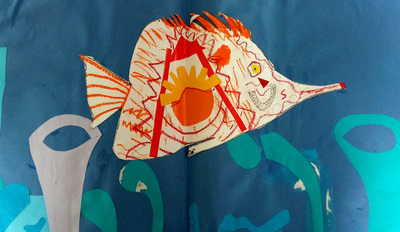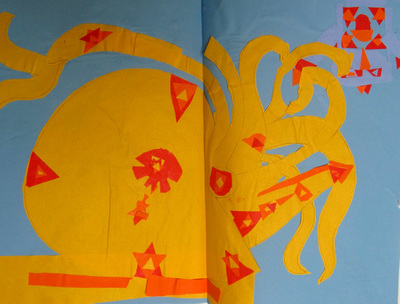Marine Matisse Collage Projects
Art Education projects with special needs children in Weston Super Mare; "Cephalopods
in the Sea", "Sea Stars", "School of Fish".
Biological diversity in the oceans has decreased dramatically since industrialization began in the 19th century. The primary causes for the losses include the destruction of habitats by trawler fishing, pollution and eutrophication of the seas, as well as the steady progress of climate change. Biological diversity is probably declining more rapidly than ever before in the history of the Earth. The world's oceans are losing their biodiversity at an accelerating rate. Overfishing is often to blame, but for animals such as marine turtles that depend on land and sea, a range of human activities now threatens their habitats at home and abroad. Coral reefs are often referred to as the rainforests of the sea, and are home to about a quarter of all known marine creatures, including green and hawksbill turtles. Sadly, one fifth of the world's reefs have already been destroyed and half are seriously threatened. We need to manage our relationship with the sea in ways that allow the wealth of marine wildlife to thrive, now and for future generations.
We learnt about:
Art Education projects with special needs children in Weston Super Mare; "Cephalopods
in the Sea", "Sea Stars", "School of Fish".
Biological diversity in the oceans has decreased dramatically since industrialization began in the 19th century. The primary causes for the losses include the destruction of habitats by trawler fishing, pollution and eutrophication of the seas, as well as the steady progress of climate change. Biological diversity is probably declining more rapidly than ever before in the history of the Earth. The world's oceans are losing their biodiversity at an accelerating rate. Overfishing is often to blame, but for animals such as marine turtles that depend on land and sea, a range of human activities now threatens their habitats at home and abroad. Coral reefs are often referred to as the rainforests of the sea, and are home to about a quarter of all known marine creatures, including green and hawksbill turtles. Sadly, one fifth of the world's reefs have already been destroyed and half are seriously threatened. We need to manage our relationship with the sea in ways that allow the wealth of marine wildlife to thrive, now and for future generations.
We learnt about:
- Different creatures who live in the sea and what makes them special
- How we can conserve, protect and regenerate life in the Sea
- Warm Colours, Cold Colours in art and the effect of global warming on life in the Sea
- How we can use recycled materials to make Art











